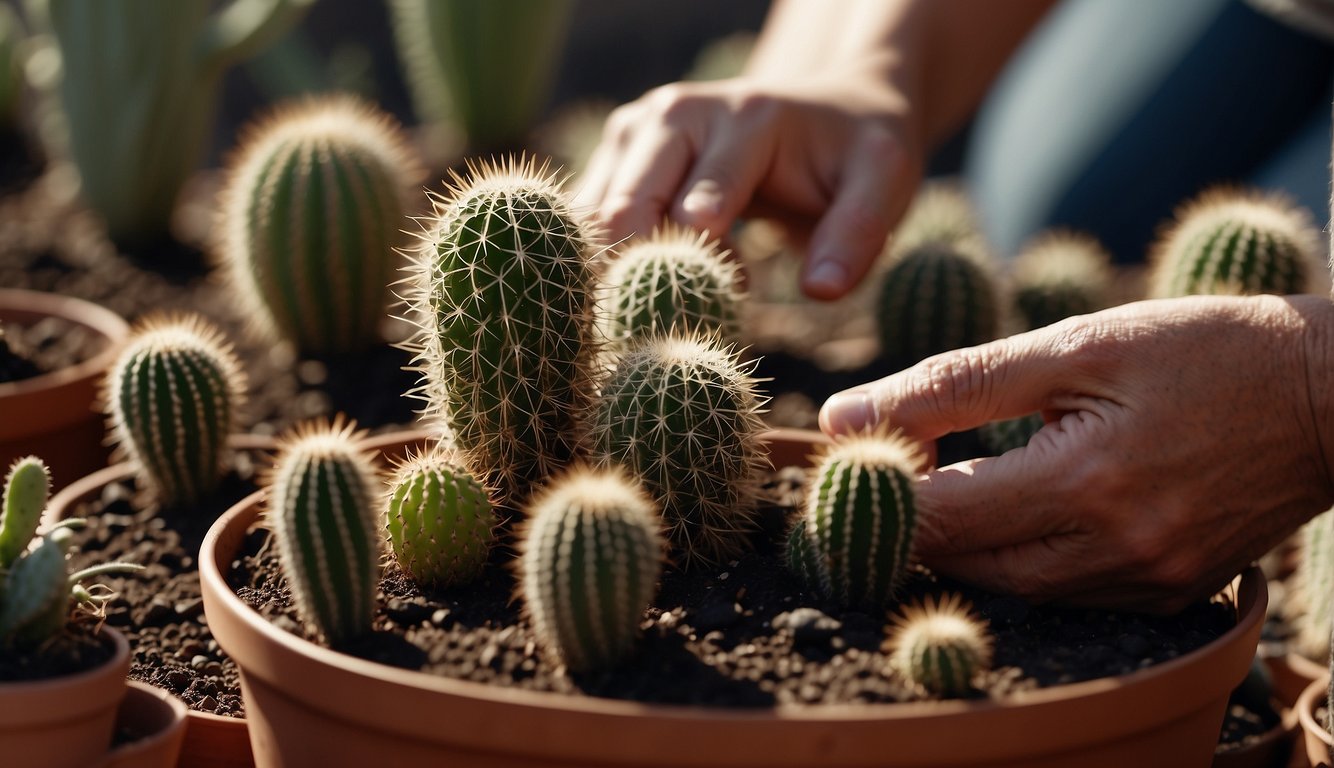TheHerbProf.com is a treasure trove of knowledge for those interested in natural healing and herbal remedies. The website is run by Paul Johnston MD. A naturopathic who has not only received extensive education in the field but also has personal experience in self-healing.
How to transplant cactus pups? If you’re a cactus enthusiast, you might be interested in propagating your own cacti. One way to do this is by transplanting cactus pups, which are small offshoots that grow from the base of the parent cactus.
Transplanting cactus pups is a great way to multiply your cactus collection and share your love of these hardy plants with others.
To get started with transplanting cactus pups, you’ll need to gather some supplies.
You’ll need a pot or container with well-draining soil or cactus-specific potting mix, a sharp knife or scissors, and some gloves to protect your hands from the cactus spines.
It’s also a good idea to have some newspaper or a towel on hand to help you handle the cactus.
When you’re ready to transplant your cactus pup, you’ll need to carefully cut it away from the parent plant using your knife or scissors.
Make sure to get as much of the root system as possible, and try not to damage the parent plant in the process.
Once you’ve removed the pup, allow the wound where you cut it to callous over for a few days before planting. This will help prevent infection and rot.
Understanding Cactus Pups – How to Transplant Cactus Pups?
Defining Cactus Pups
As a cactus grows, it produces new offshoots or baby cacti called “pups” or “offsets” that grow from the base of the parent plant. These cactus pups are genetically identical to the parent plant and can be separated and replanted to grow into new individual plants.
They are usually small and can be as tiny as a few millimeters or as large as a few inches, depending on the species of cactus.
Growth Patterns
Cactus pups grow in various patterns depending on the species of cactus. Some grow in clusters around the base of the parent plant, while others grow on the sides or top of the parent plant.
Some cacti produce pups once a year, while others produce them continuously throughout the year. Understanding the growth patterns of your cactus can help you determine the best time to transplant the pups.
It is important to note that cactus pups should not be removed from the parent plant until they are large enough to survive on their own.
Removing them too early can cause damage to both the parent plant and the pup, and may result in the death of both.
It is also important to handle cactus pups with care, as they are delicate and can be easily damaged.
Preparation for Transplanting – How to Transplant Cactus Pups?

Transplanting cactus pups can be a rewarding experience for gardeners. However, before you start the process, it is important to make sure you have everything you need. Here are some key steps to take in preparation for transplanting a cactus pup.
Selecting the Right Time
The best time to transplant a cactus pup is during the spring or summer months when the plant is actively growing. This will give the pup the best chance of establishing itself in its new environment.
Gathering Necessary Tools and Supplies
In order to successfully transplant a cactus pup, you will need a few tools and supplies.
These include a sharp knife, gloves, a pot with drainage holes, and a well-draining cactus mix.
You may also want to consider adding perlite, sand, peat, or compost to your mix to improve drainage and nutrient content.
Choosing the Appropriate Soil Mix
Choosing the right soil mix is crucial for the success of your cactus pup transplant.
A well-draining cactus mix is essential, as cacti are susceptible to root rot if they are left in soil that is too moist.
You can make your own mix by combining potting soil, perlite, and sand, or you can purchase a pre-made cactus mix from a garden center.
Removing Cactus Pups – How to Transplant Cactus Pups?
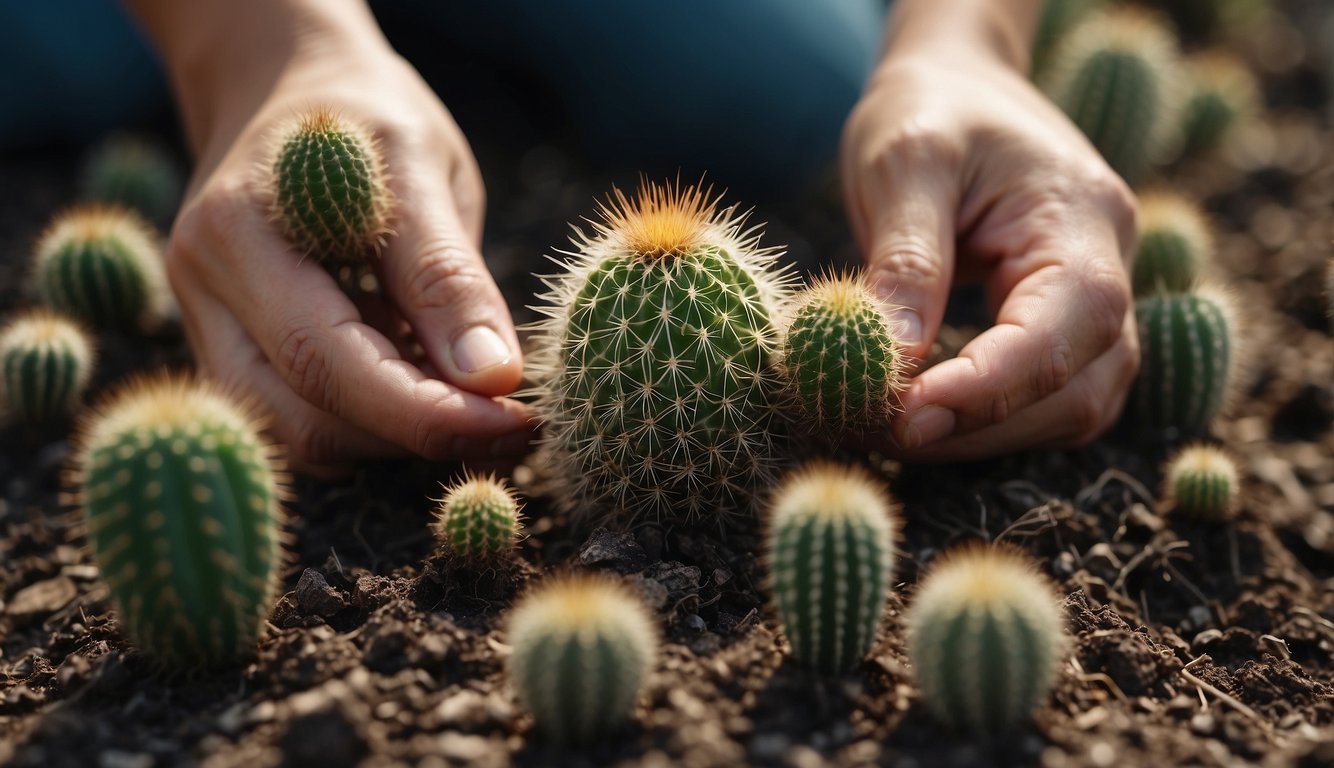
As a cactus enthusiast, I have learned how to propagate cacti through various methods, including removing cactus pups. This technique involves detaching a small cactus plant from its parent plant and growing it separately. Here are some safety measures and steps to follow when removing cactus pups.
Safety Measures
Before removing cactus pups, it is essential to take safety measures since cacti have sharp spines that can cause injury.
Wearing gloves and using a sharp knife are necessary precautions to take to avoid getting pricked by the spines.
I recommend using a clean, sharp knife to cut the pup away from the parent plant. A dull knife can damage the stem and roots, making it difficult for the pup to survive.
Detaching Pups from Parent Plant
The first step in removing a cactus pup is to ensure that the parent plant is healthy.
A healthy parent plant will have enough moisture and nutrients to support the growth of the pup.
It is also essential to ensure that the parent plant has enough spines to protect itself from pests and diseases.
To detach the pup, I use a sharp knife to cut it away from the parent plant at a 45-degree angle.
I make sure to get as much of the root system as possible to ensure the pup has enough nutrients to survive.
After detaching the pup, I allow the wound to callus over for a few days before planting it. This helps prevent infection and rot.
Potting Cactus Pups – How to Transplant Cactus Pups?
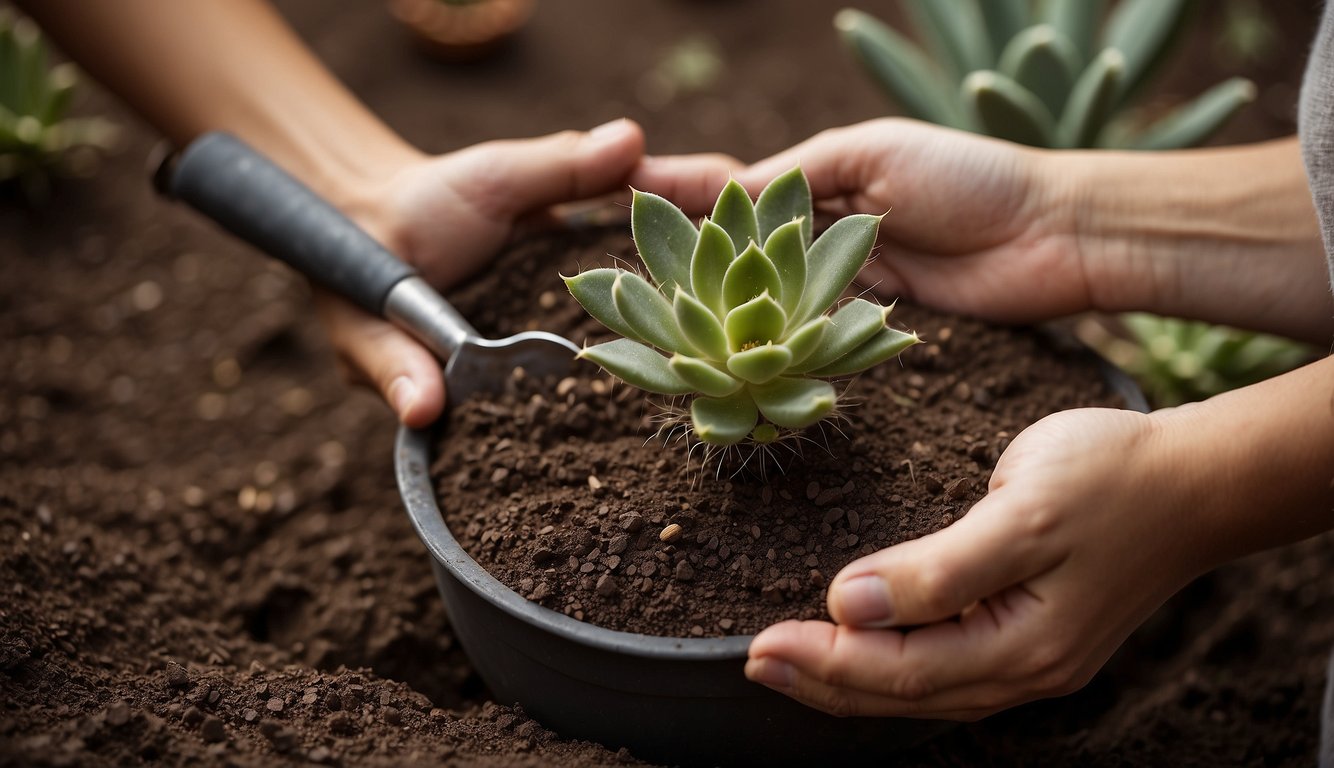
When transplanting a cactus pup, potting is a crucial step that requires careful attention. Here are some important factors to consider when potting your cactus pup:
Selecting the Right Container
Selecting the right container is essential for the successful growth of your cactus pup.
The container should be slightly larger than the root ball of the cactus pup.
It is recommended to use a pot with drainage holes to avoid overwatering.
Ensuring Proper Drainage
Proper drainage is crucial for the health of your cactus pup.
Ensure that the container has a drainage hole at the bottom to allow excess water to drain out.
To prevent the soil from clogging the drainage holes, place a layer of rocks or gravel at the bottom of the pot before adding the soil.
Planting the Cactus Pup
When planting the cactus pup, use well-draining soil to prevent waterlogging.
Fill the pot with the soil mixture and create a small hole in the center.
Place the cactus pup in the hole and gently press the soil around it.
Ensure that the soil is firmly packed around the cactus pup, but avoid compacting it too tightly.
Caring for Transplanted Cactus Pups
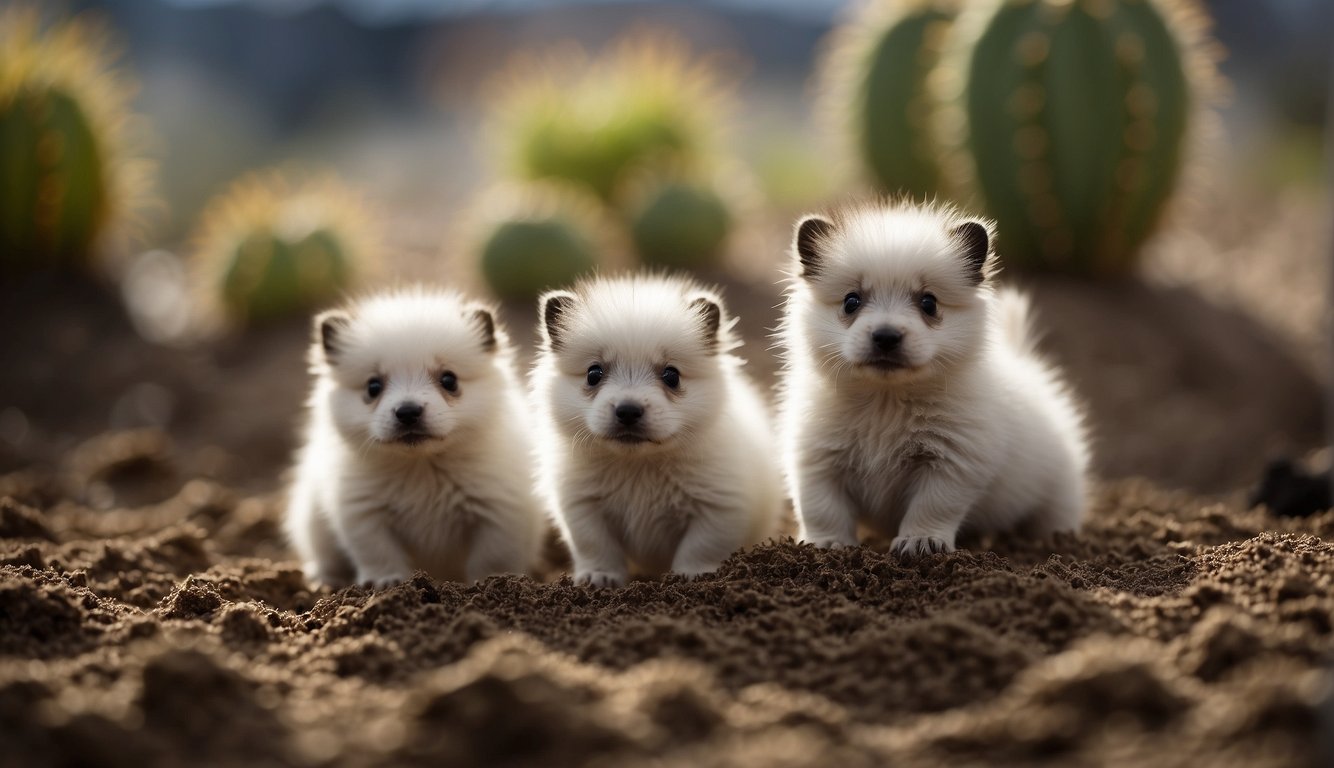
Transplanting cactus pups can be a bit stressful for the new plant, so it’s important to take proper care of them to ensure their healthy growth. Here are some tips on how to care for your newly transplanted cactus pups.
Initial Watering and Sunlight Exposure
After transplanting your cactus pup, it’s important to give it an initial watering to help it settle into its new soil.
Water the plant sparingly, making sure not to overwater it, as cactus pups have shallow root systems that can easily rot if overwatered.
When it comes to sunlight exposure, cactus pups prefer bright, indirect light.
Avoid exposing them to direct sunlight, especially during the hottest part of the day.
Gradually increase the amount of sunlight exposure over time to help the plant adjust.
Maintaining Soil Moisture and Fertilizing
Maintaining proper soil moisture is crucial for the healthy growth of your cactus pup.
While cacti are known for their ability to tolerate drought, they still need regular watering to thrive.
Set up a regular watering schedule, making sure to water the plant deeply enough to reach the roots.
Fertilizing your new plant can also help promote healthy growth.
Use a balanced fertilizer specifically formulated for cacti and succulents, and apply it according to the instructions on the package.
Be careful not to over-fertilize, as this can stress the plant and cause damage.
Monitoring Growth and Health
Keeping an eye on the growth and health of your cactus pup is important to catch any potential issues early on.
Look out for signs of stress, such as wilting or discoloration, and take action to address the issue promptly.
Cactus pups are susceptible to a variety of diseases and pests, so it’s important to keep an eye out for any signs of infestation.
If you notice any issues, try using a fungicide or insecticide specifically formulated for cacti and succulents.
Troubleshooting Common Issues – How to Transplant Cactus Pups?

Transplanting cactus pups can be a rewarding experience, but it’s not always smooth sailing. Here are some common issues that you may encounter and how to troubleshoot them.
Preventing Root Rot
Root rot is a common issue that can occur when the roots of a cactus are exposed to too much moisture.
To prevent root rot, it’s important to ensure that your cactus is planted in well-draining soil and that the soil is allowed to dry out completely between waterings.
Overwatering is one of the most common causes of root rot, so be sure to water your cactus sparingly.
Dealing with Pests and Diseases
Pests and diseases can also be a problem when transplanting cactus pups.
Some common pests that can infest cacti include mealybugs, spider mites, and scale insects. If you notice any signs of infestation, such as white or fuzzy spots on the plant, it’s important to take action right away.
One way to deal with pests is to remove them manually using a cotton swab dipped in rubbing alcohol.
You can also use a mild insecticide or soap solution to kill off the pests.
If your cactus is suffering from a disease, such as a fungal infection, you may need to apply a fungicide to help it recover.
Addressing Transplant Shock
Transplant shock is a common issue that can occur when a cactus is moved from one location to another.
Symptoms of transplant shock can include wilting, yellowing, and stunted growth.
To help your cactus recover from transplant shock, it’s important to provide it with plenty of water and nutrients.
You may also want to consider adding a layer of mulch around the base of the plant to help retain moisture.
Propagating Cactus Pups Beyond Transplanting

As a cactus enthusiast, I find propagating cactus pups to be an exciting and rewarding process.
Once you have successfully transplanted your cactus pup, there are a few additional steps you can take to encourage root development and expand your cactus collection.
Encouraging Root Development
After transplanting your cactus pup, it is essential to provide it with the proper care to encourage root development.
During the growing season, which typically occurs from late spring to early summer, it is crucial to keep the soil moist but not waterlogged.
Overwatering can lead to root rot, which can be fatal to your cactus pup.
In addition to proper watering, you can also encourage root development by using a rooting hormone.
This hormone contains auxins, which stimulate root growth and can help your cactus pup establish a strong root system.
Simply dip the cut end of the pup into the rooting hormone and plant it in well-draining soil.
Expanding Your Cactus Collection
Once you have successfully propagated your cactus pup, you can use the same techniques to propagate other species of cactus.
Propagating cacti can be done through seeds or cuttings, but using pups is often the easiest and most reliable method.
Expanding your cactus collection can be a fun and rewarding hobby.
With so many different species of cactus available, there is always something new to discover.
How to Transplant Cactus Pups and TheHerbProf.com: A Prickly Partnership
Cactus pups! They’re the cute little offshoots that promise new life. But how to transplant them? That’s where theherbprof.com comes in!
On theherbprof.com, you’ll find tips and tricks for transplanting cactus pups. It’s like having a personal cactus companion at your fingertips! But how does this tie in with cactus pups, you ask?
Imagine this. You’ve got a cactus. It’s sturdy and spiky, but it’s sprouting pups. You stumble upon theherbprof.com and find a guide on how to transplant these little ones. Suddenly, your cactus pups are thriving in their new homes!
But the fun doesn’t stop there. You can share your cactus pup success story on theherbprof.com, helping others in the community with similar cactus curiosities. It’s a win-win situation!
So, whether you’re a cactus caretaker or just curious about these prickly plants, theherbprof.com is your one-stop-shop. And remember, every cactus pup is an opportunity to learn and grow.
References – How to Transplant Cactus Pups?
Little Herb Encyclopedia, by Jack Ritchason; N.D., Woodland Publishing Incorporated, 1995
The Ultimate Healing System, Course Manual, Copyright 1985, Don Lepore
Planetary Herbology, Michael Tierra, C.A., N.D., Lotus Press, 1988
Handbook of Medicinal Herbs, by James A. Duke, Pub. CRP Second Edition 2007
The Complete Medicinal Herbal, by Penelope Ody, Published by Dorling Kindersley
Check the Following Articles!
Why Use Raised Garden Beds: All You Need To Know!
Jade Pruning: How to Properly Trim Your Jade Plant
Ollas Irrigation: An Ancient Method for Watering Plants
Planting Marigolds in Vegetable Garden: Tips and Tricks
Frequently Asked Questions – How to Transplant Cactus Pups?
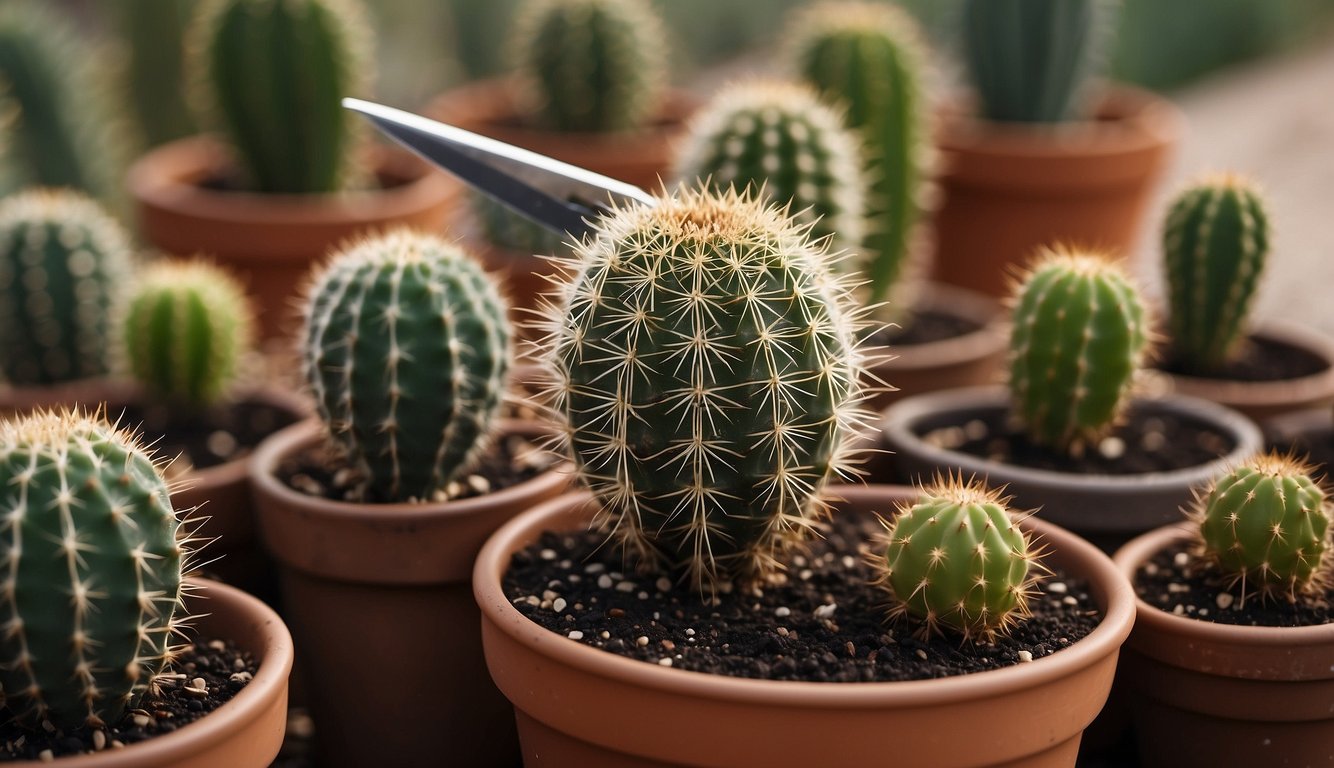
When is the best time to transplant cactus pups?
The best time to transplant cactus pups is during the spring when most cacti are actively growing and have the highest chances of rooting successfully.
It is important to avoid transplanting during the winter since cacti are dormant and may not be able to handle the stress of transplantation [1].
How do you prepare the soil for transplanting cactus pups?
To prepare the soil for transplanting cactus pups, you need to mix coarse sand, crushed charcoal, and cactus compost in equal amounts.
Fill the bottom of the pot with gravel and charcoal to a height of 1 inch. Add some coarse sand and small gravel on top. The compost is then added. You can add more small rocks or gravel on top of the compost [5].
What is the proper technique for separating cactus pups from the parent plant?
The proper technique for separating cactus pups from the parent plant is to use a sharp, sterile knife or garden shears.
Cut the pup as close to the parent plant as possible, making sure to avoid damaging the roots of both the parent plant and the pup.
You can also gently twist the pup to separate it from the parent plant. Allow the pup to dry for a few days before planting [2].
How long should cactus pups dry before planting?
Cactus pups should be allowed to dry for a few days before planting to allow the wound to callus over. This will help prevent the pup from rotting when planted in soil. Once the pup has callused over, it is ready to be planted in soil [1].
Can cactus pups be propagated in water before soil transplantation?
Cactus pups can be propagated in water before soil transplantation, but this is not recommended.
Cacti are adapted to dry environments and can be damaged by too much moisture. Propagating in water can also cause the roots to become soft and weak, making it harder for the pup to establish itself when planted in soil [2].
What are the signs that a cactus pup is ready to be transplanted?
The signs that a cactus pup is ready to be transplanted include the presence of roots and a callused wound. Once the pup has developed roots and the wound has callused over, it is ready to be planted in soil.
It is important to avoid transplanting too early since this can damage the pup and prevent it from establishing itself in the new pot [4].
